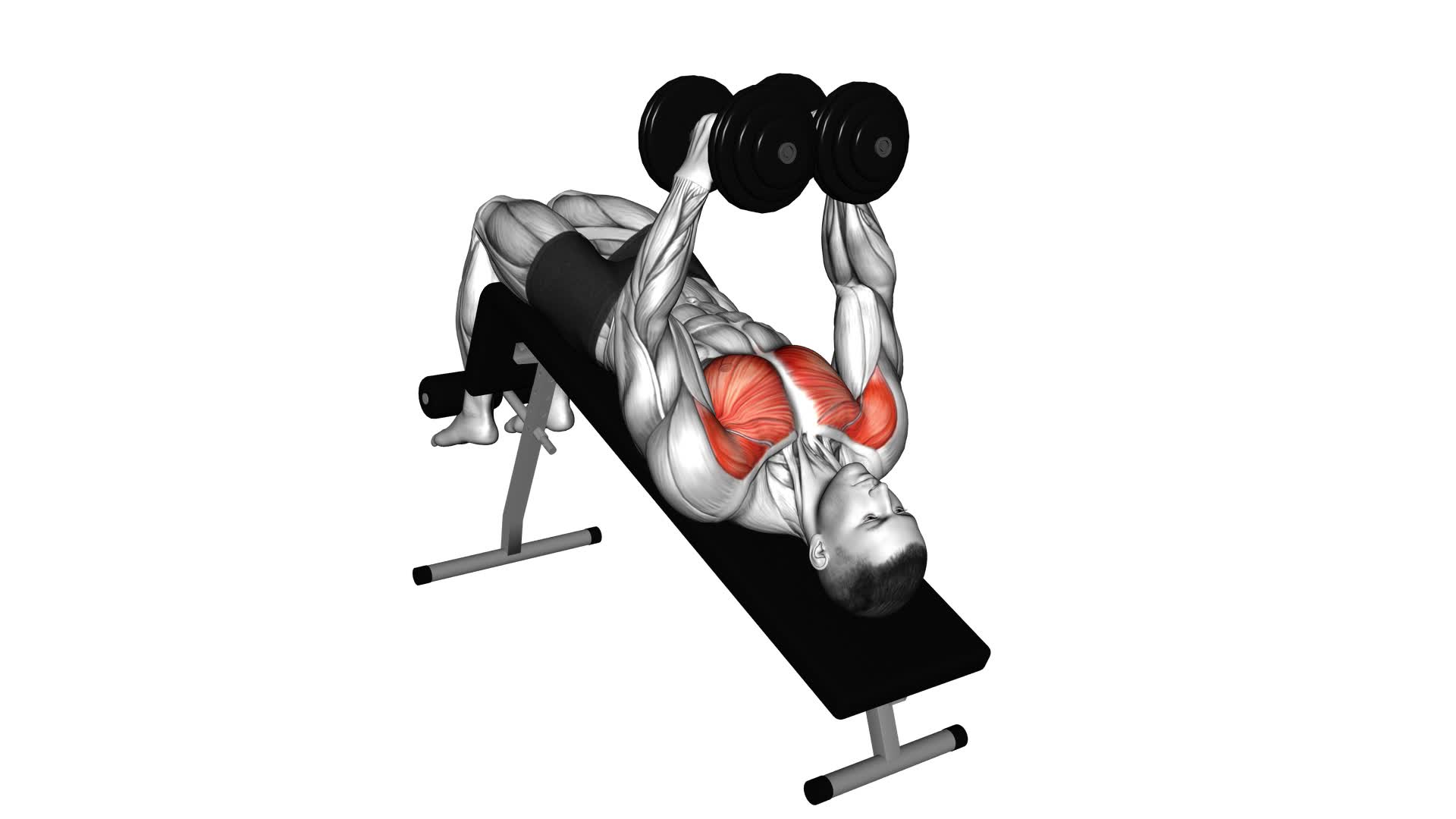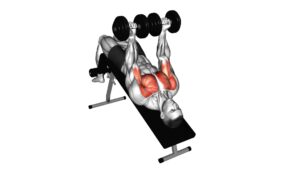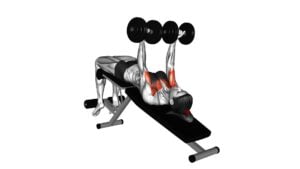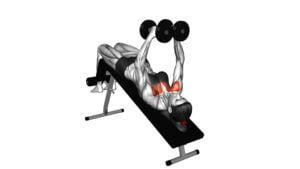Dumbbell Decline Fly – Video Exercise Guide & Tips

Are you looking for a challenging exercise to target your chest muscles? Then the dumbbell decline fly is perfect for you.
Watch This Exercise Video
This exercise, demonstrated in a helpful video guide, will help you strengthen and tone your chest while also engaging your shoulders and arms.
By following the proper form and technique, you can maximize the effectiveness of this exercise and avoid common mistakes.
Get ready to take your chest workout to the next level with the dumbbell decline fly.
Key Takeaways
- The dumbbell decline fly is a highly effective exercise for targeting and developing the upper chest muscles.
- Incorporating variations of the exercise, such as the incline dumbbell fly and single-arm dumbbell decline fly, can help target different areas of the chest and maximize benefits.
- Proper form and technique, including maintaining a controlled movement and keeping the elbows slightly bent and wrists in a neutral position, are crucial for maximizing the effectiveness of the exercise and preventing injury.
- Gradually increasing resistance and focusing on controlled and deliberate movements can help continually challenge the muscles and promote muscle growth.
Benefits of the Dumbbell Decline Fly
You can experience significant upper chest muscle growth by incorporating the dumbbell decline fly into your workout routine. The dumbbell decline fly is a versatile exercise that offers various variations for targeting chest muscles. By adding these variations to your training regimen, you can maximize the benefits and achieve better results.
One variation of the dumbbell decline fly is the incline dumbbell fly. This exercise is performed on an incline bench, which targets the upper chest muscles more effectively. By adjusting the angle of the bench, you can increase or decrease the intensity of the exercise.
Another variation is the single-arm dumbbell decline fly. This variation requires you to perform the exercise one arm at a time, allowing for better isolation of the chest muscles. By focusing on one side at a time, you can correct any imbalances and develop a symmetrical chest.
Additionally, you can incorporate the decline push-up with dumbbells into your routine. This variation combines the benefits of the dumbbell decline fly and the push-up, providing a challenging workout for your chest muscles.
Proper Form and Technique
To perform the dumbbell decline fly with proper form and technique, it's important to focus on maintaining a stable and controlled movement throughout the exercise. This will ensure that you're targeting the right muscles and avoiding any unnecessary strain or injuries. Here are some tips to help you achieve the proper form:
- Lie down on a decline bench with your feet secured and your head at the lower end of the bench.
- Hold a dumbbell in each hand with your palms facing each other and your arms extended above your chest.
- Lower the dumbbells in a controlled manner out to the sides, maintaining a slight bend in your elbows.
- As you lower the dumbbells, imagine hugging a big tree, feeling the stretch in your chest muscles.
- Keep your elbows slightly bent and your wrists in a neutral position throughout the movement.
- Slowly bring the dumbbells back to the starting position, squeezing your chest muscles at the top of the movement.
Equipment Needed for the Exercise
To perform the dumbbell decline fly with proper form and technique, you'll need a decline bench and a pair of dumbbells. The decline bench is specifically designed to target the lower chest muscles, as it allows you to perform the exercise on a downward angle. This angle increases the range of motion and activates the lower chest muscles more effectively. The dumbbells are essential for providing resistance and challenging your muscles during the exercise.
Using dumbbells for the decline fly exercise has several benefits. First, it allows for a greater range of motion compared to using a barbell. This increased range of motion helps to stretch and activate the chest muscles more effectively. Second, dumbbells require more stabilization, which engages the core muscles and improves overall strength and stability. Lastly, using dumbbells allows for bilateral movement, meaning each side of your body works independently. This helps to address any muscle imbalances and ensures equal development of both sides.
There are variations of decline fly exercises that can be performed to target different areas of the chest. For example, you can try incline dumbbell flyes, which target the upper chest muscles. You can also experiment with different angles on the decline bench to adjust the focus of the exercise. By adjusting the bench to a steeper angle, you'll place more emphasis on the lower chest muscles, while a shallower angle will target the middle chest muscles.
Step-by-Step Guide to Performing the Exercise
Now let's dive into the step-by-step guide for performing the dumbbell decline fly exercise.
To ensure proper technique, it's important to pay attention to a few key points.
We'll discuss the correct form, common mistakes to avoid, and the benefits you can expect from incorporating this exercise into your routine.
Technique Tips
Start by lying on a decline bench with a dumbbell in each hand. To ensure proper technique and maximize the effectiveness of the dumbbell decline fly exercise, keep the following tips in mind:
- Common Errors:
- Avoid using excessive weight, as it can lead to poor form and potential injury.
- Don't arch your back or lift your hips off the bench, as this can strain your lower back.
- Avoid fully extending your arms at the top of the movement, as it can put unnecessary stress on your shoulder joints.
- Variations:
- Instead of using dumbbells, you can also perform the decline fly exercise using a barbell or a cable machine.
- If you want to target your inner chest muscles, you can bring your hands closer together while performing the exercise.
Remember to always start with a weight that you can comfortably handle and gradually increase as you become stronger.
Common Mistakes
One common mistake when performing the dumbbell decline fly exercise is using excessive weight, which can lead to poor form and potential injury. It's important to use a weight that allows you to maintain proper technique throughout the exercise.
Another common mistake isn't fully extending your arms during the movement. This can limit the range of motion and reduce the effectiveness of the exercise. To avoid this, make sure to fully extend your arms when bringing the dumbbells together in front of your chest.
Additionally, it's crucial to keep your core and glutes engaged throughout the exercise to maintain stability and prevent strain on your lower back. Remember to always prioritize proper technique over the amount of weight you're lifting to ensure a safe and effective workout.
Benefits of Exercise
To maximize the benefits of the dumbbell decline fly exercise, focus on maintaining proper form and engaging your targeted muscles throughout the movement. This exercise offers numerous advantages for your physical and mental well-being. Here are two key benefits to keep in mind:
- Impact of exercise on mental health:
Regular exercise, like the dumbbell decline fly, has been shown to have a positive impact on mental health. It can help reduce symptoms of depression and anxiety, improve mood, and boost overall mental well-being. By incorporating this exercise into your routine, you can experience the mental health benefits that exercise has to offer.
- Exercise as a preventative measure for chronic diseases:
Engaging in regular exercise, such as the dumbbell decline fly, can help prevent chronic diseases such as heart disease, diabetes, and certain types of cancer. By consistently challenging your muscles and cardiovascular system, you can improve your overall health and reduce the risk of developing these debilitating conditions.
Common Mistakes to Avoid
To avoid common mistakes while performing the dumbbell decline fly exercise, ensure proper form and technique. This won't only help you get the most out of the exercise but also prevent any potential injuries. One common mistake to avoid is using too much weight. It's important to start with a weight that you can comfortably handle and gradually increase it as you get stronger.
Another mistake is using momentum instead of controlled movements. Remember to perform the exercise in a slow and controlled manner, focusing on squeezing your chest muscles at the top of the movement. Additionally, make sure to keep your back flat on the bench throughout the exercise to avoid straining your lower back.
If you find the dumbbell decline fly too challenging or uncomfortable, there are alternative exercises you can try. One option is the cable fly, which allows for a greater range of motion and can be easier on your joints. Another alternative is the chest press machine, which provides more stability and support. Remember, it's important to listen to your body and choose exercises that work for you.
Tips for Maximizing the Effectiveness of the Dumbbell Decline Fly
To maximize the effectiveness of the dumbbell decline fly, focus on maintaining proper form and incorporating these tips into your workout routine:
- Vary your grip: By using different grip variations, such as a neutral grip or a pronated grip, you can target different areas of your chest. Experiment with different grips to find what works best for you and to maximize your results.
- Modify the angle: Adjusting the decline bench to different angles can change the emphasis of the exercise. Lower angles will target your lower chest, while higher angles will focus more on your upper chest. Incorporating different angles into your routine will help you work all areas of your chest effectively.
- Use proper technique: It's crucial to maintain proper form throughout the exercise. Keep your back flat against the bench, engage your core, and avoid using momentum to lift the weights. By focusing on controlled and deliberate movements, you'll maximize the effectiveness of the exercise and reduce the risk of injury.
- Increase resistance gradually: To continue challenging your muscles and maximizing your results, gradually increase the weight you're using. Start with a weight that allows you to perform the exercise with proper form, and then gradually increase the resistance as you become stronger.
Frequently Asked Questions
How Many Sets and Reps Should I Do for the Dumbbell Decline Fly?
To maximize the benefits of the dumbbell decline fly for your chest muscles, it's important to focus on proper form and technique. When it comes to sets and reps, it's recommended to start with 3 sets of 10-12 reps.
This will help you build strength and muscle endurance. As you progress, you can increase the weight and decrease the reps for a more challenging workout. Remember to always maintain control and engage your chest muscles throughout the exercise.
Can I Perform the Dumbbell Decline Fly With a Flat Bench Instead of a Decline Bench?
Yes, you can perform the dumbbell decline fly with a flat bench instead of a decline bench.
However, using a decline bench allows for a greater range of motion and targets the lower chest muscles more effectively.
If you don't have access to a decline bench, you can try alternative exercises like the push-up or the incline dumbbell fly to still work your chest muscles from different angles.
Is It Necessary to Have a Spotter When Performing the Dumbbell Decline Fly?
When performing the dumbbell decline fly, it's important to consider whether or not you need a spotter. Having a spotter during weightlifting can provide numerous benefits, such as ensuring proper form and preventing injury.
However, if you don't have a spotter available, there are alternative exercises you can do to develop your chest, such as the dumbbell bench press or push-ups. Remember to always prioritize safety and listen to your body when working out.
Can I Substitute the Dumbbell Decline Fly With Other Exercises Targeting the Same Muscles?
Yes, you can substitute the dumbbell decline fly with other exercises that target the same muscles. There are several options you can try, such as the cable fly, push-ups, or chest press machine.
These exercises also work your chest muscles and provide a similar range of motion. Remember to maintain proper form and gradually increase the weight or intensity to challenge your muscles and continue making progress.
Always consult with a fitness professional to ensure you're performing the exercises correctly.
How Often Should I Incorporate the Dumbbell Decline Fly Into My Workout Routine?
To maximize the benefits of the dumbbell decline fly, it's important to incorporate it into your workout routine regularly. Aim to perform this exercise at least once or twice a week.
This will help target and strengthen your chest muscles, specifically the lower portion.
Additionally, you can vary your routine by using different variations of the dumbbell decline fly, such as alternating arms or using different weights.
Remember to always maintain proper form and gradually increase the intensity as you progress.
Conclusion
In conclusion, the dumbbell decline fly is a highly effective exercise for targeting the chest muscles. By following the proper form and technique, using the necessary equipment, and avoiding common mistakes, you can maximize the effectiveness of this exercise.
Remember to start with lighter weights and gradually increase as you build strength. Incorporate the dumbbell decline fly into your workout routine to improve your chest strength and overall upper body fitness.

Author
Years ago, the spark of my life’s passion ignited in my mind the moment I stepped into the local gym for the first time. The inaugural bead of perspiration, the initial endeavor, the very first surge of endorphins, and a sense of pride that washed over me post-workout marked the beginning of my deep-seated interest in strength sports, fitness, and sports nutrition. This very curiosity blossomed rapidly into a profound fascination, propelling me to earn a Master’s degree in Physical Education from the Academy of Physical Education in Krakow, followed by a Sports Manager diploma from the Jagiellonian University. My journey of growth led me to gain more specialized qualifications, such as being a certified personal trainer with a focus on sports dietetics, a lifeguard, and an instructor for wellness and corrective gymnastics. Theoretical knowledge paired seamlessly with practical experience, reinforcing my belief that the transformation of individuals under my guidance was also a reflection of my personal growth. This belief holds true even today. Each day, I strive to push the boundaries and explore new realms. These realms gently elevate me to greater heights. The unique combination of passion for my field and the continuous quest for growth fuels my drive to break new ground.







